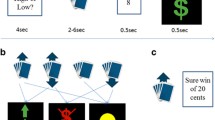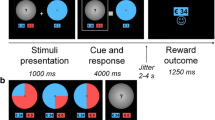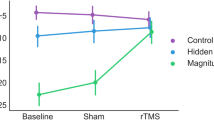Abstract
Intertemporal choice refers to decisions that need to weigh different rewards at different time points in the future. Decision impulsivity manifests in the tendency of choosing smaller immediate options rather than larger later ones. Previous studies have suggested that decision impulsivity in intertemporal decision-making shares similar cognitive and neural mechanisms with risky decision-making. The present study theorizes on and examines whether the activation patterns of the dorsal medial prefrontal cortex (DMPFC) and the frontal pole (FP) during the risk-taking “cups task”, as captured in the scanner, can predict the delay discounting rate (k) based on an intertemporal decision task performed outside the scanner. To this end, we scanned with functional magnetic resonance imaging (fMRI) techniques a sample of 257 college students (N = 257) while performing the cups task. Univariate analyses showed that activation levels of the DMPFC and the FP were inversely correlated with risk preference, but not with the delay discounting rate k. Multivariate pattern analysis, which can overcome key limitations of the univariate analyses, showed that activation patterns of these two regions predict the delay discounting rate k. These results confirmed the important roles of DMPFC and FP in decision impulsivity and the utility of using multivariate pattern analysis with fMRI data involving decision making tasks.



Similar content being viewed by others
References
Acheson, A., Farrar, A. M., Patak, M., Hausknecht, K. A., Kieres, A. K., Choi, S.,.. . Richards, J. B. (2006). Nucleus accumbens lesions decrease sensitivity to rapid changes in the delay to reinforcement. Behavioural Brain Research, 173(2), 217–228.
Ainslie, G. (1975). Specious reward: A behavioral theory of impulsiveness and impulse control. Psychological Bulletin, 82(4), 463–496.
Andersson, J. L. R., Jenkinson, M., & Smith, S. (2007a). Non-linear optimisation. FMRIB Technial Report TR07JA1.
Andersson, J. L. R., Jenkinson, M., & Smith, S. (2007b). Non-linear registration, aka spatial normalisation. In FMRIB technical report TR07JA2: Oxford, United Kingdom FMRIB Centre.
Bechara, A. (2005). Decision making, impulse control and loss of willpower to resist drugs: a neurocognitive perspective. Nature Neuroscience, 8(11), 1458–1463.
Bechara, A., Tranel, D., & Damasio, H. (2000). Characterization of the decision-making deficit of patients with ventromedial prefrontal cortex lesions. Brain, 123(11), 2189–2202.
Bechara, A., Dolan, S., & Hindesa, A. (2002). Decision-making and addiction (part II): myopia for the future or hypersensitivity to reward? Neuropsychologia, 40(10), 1690–1705.
Bechara, A., Tranel, D., Damasio, H., & Damasio, A. R. (1996). Failure to respond autonomically to anticipated future outcomes following damage to prefrontal cortex. Cerebral Cortex, 6(2), 215–225.
Beck, A., Schlagenhauf, F., Wustenberg, T., Hein, J., Kienast, T., Kahnt, T., & Wrase, J. (2009). Ventral striatal activation during reward anticipation correlates with impulsivity in alcoholics. Biological Psychiatry, 66(8), 734–742. http://sci-hub.tw/10.1016/j.biopsych.2009.04.035.
Clark, L., Bechara, A., Damasio,H., Aitken, M. R. F., Sahakian, B. J., & Robbins, T. W. (2008). Differential effects of insular and ventromedial prefrontal cortex lesions on risky decision-making. Brain, 131(5), 1311–1322.
Fellows, L. K., & Farah, M. J. (2007). The role of ventromedial prefrontal cortex in decision making: judgment under uncertainty or judgment per se? Cerebral Cortex, 17(11), 2669–2674.
Frederick, S., Loewenstein, G., & O'Donoghue, T. (2002). Time Discounting and Time Preference: A Critical Review. Journal of Economic Literature, 40(2), 351–401.
Glimcher, P. W., & Aldo, R. (2004). Neuroeconomics: the consilience of brain and decision. Science, 306(5695), 447–452.
Green, L., & Myerson, J. (2004). A discounting framework for choice with delayed and probabilistic rewards. Psychological Bulletin, 130(5), 769–792.
Green, L., Myerson, J., & Ostaszewski, P. (1999). Amount of reward has opposite effects on the discounting of delayed and probabilistic outcomes. Journal of Experimental Psychology Learning Memory & Cognition, 25(2), 418–427.
He, Q., Xue, G., Chen, C., Chen, C., Lu, Z. L., & Dong, Q. (2013). Decoding the neuroanatomical basis of reading ability: a multivoxel morphometric study. The Journal of Neuroscience, 33(31), 12835–12843. https://doi.org/10.1523/JNEUROSCI.0449-13.2013
Holt, C. A., & Laury, S. K. (2002). Risk aversion and incentive effects. American Economic Review, 92(5), 1644–1655.
Huang, Y.-F., Soon, C. S., O’Dhaniel, A., & Hsieh, P.-J. (2014). Pre-existing brain states predict risky choices. NeuroImage, 101, 466–472.
Huang, X., Zhang, H., Chen, C., Xue, G., & He, Q. (2019). The neuroanatomical basis of the Gambler’s fallacy: a univariate and multivariate morphometric study. Human Brain Mapping, 40(3), 104–112.
Jenkinson, M., & Smith, S. (2001). A global optimisation method for robust affine registration of brain images. Medical Image Analysis, 5(2), 143–156.
Kable, J. W., & Glimcher, P. W. (2007). The neural correlates of subjective value during intertemporal choice. Nature Neuroscience, 10(12), 1625–1633. https://doi.org/10.1038/nn2007
Kim, H., Shimojo, S., & O’Doherty, J. P. (2006). Is avoiding an aversive outcome rewarding? Neural substrates of avoidance learning in the human brain. PLoS Biology, 4(8), e233. https://doi.org/10.1371/journal.pbio.0040233
Kriegeskorte, N., Simmons, W. K., Bellgowan, P. S. F., & Baker, C. I. (2009). Circular analysis in systems neuroscience: the dangers of double dipping. Nature Neuroscience, 12(5), 535–540.
Lee, D., Rushworth, M. F., Walton, M. E., Watanabe, M., & Sakagami, M. (2007). Functional specialization of the primate frontal cortex during decision making. The Journal of Neuroscience, 27(31), 8170–8173.
Loewenstein, G. F. (1988). Frames of mind in intertemporal choice. Management Science, 32(4), 200–214.
Luhmann, C. C., Chun, M. M., Yi, D. J., Lee, D., & Wang, X. J. (2008). Neural dissociation of delay and uncertainty in intertemporal choice. The Journal of Neuroscience, 28(53), 14459–14466. https://doi.org/10.1523/JNEUROSCI.5058-08.2008
Luo, S., Ainslie, G., Giragosian, L., & Monterosso, J. R. (2009). Behavioral and neural evidence of incentive bias for immediate rewards relative to preference-matched delayed rewards. Journal of Neuroscience, 29(47), 14820–14827.
Luo, S., Ainslie, G., Pollini, D., Giragosian, L., & Monterosso, J. R. (2012). Moderators of the association between brain activation and farsighted choice. NeuroImage, 59(2), 1469–1477.
Lv, C., Wang, Q., Chen, C., Qiu, J., Xue, G., & He, Q. (2019). The regional homogeneity patterns of the dorsal medial prefrontal cortex predict individual differences in decision impulsivity. NeuroImage, 200, 556–561.
McClure, S. M., Laibson, D. I., Loewenstein, G., & Cohen, J. D. (2004). Separate neural systems value immediate and delayed monetary rewards. Science, 306(5695), 503–507.
Mitchell, J. P., Jessica, S., Ames, D. L., & Gilbert, D. T. (2011). Medial prefrontal cortex predicts intertemporal choice. Journal of Cognitive Neuroscience, 23(4), 857–866.
Mur, M., Bandettini, P. A., & Kriegeskorte, N. (2009). Revealing representational content with pattern-information fMRI–an introductory guide. Social Cognitive and Affective Neuroscience, 4(1), 101–109.
Myerson, J., Green, L., Hanson, J. S., Holt, D. D., & Estle, S. J. (2003). Discounting delayed and probabilistic rewards: Processes and traits. Journal of Economic Psychology, 24(5), 619–635.
Peters, J. & Büchel (2009). Overlapping and distinct neural systems code for subjective value during intertemporal and risky decision making. Journal of Neuroscience, 29(50), 15727–15734.
Peters, J., & Büchel, C. (2010). Episodic Future Thinking Reduces Reward Delay Discounting through an Enhancement of Prefrontal-Mediotemporal Interactions. Neuron, 66(1), 138–148. https://doi.org/10.1016/j.neuron.2010.03.026
Peters, J., & Büchel, C. (2011). The neural mechanisms of inter-temporal decision-making: understanding variability. Trends in Cognitive Sciences, 15(5), 227–239. https://doi.org/10.1016/j.tics.2011.03.002
Phan, K. L., Wager, T., Taylor, S. F., & Liberzon, I. (2002). Functional neuroanatomy of emotion: a meta-analysis of emotion activation studies in PET and fMRI. NeuroImage, 16(2), 331–348.
Shiv, B., Loewenstein, G., & Bechara, A. (2005). The dark side of emotions in decision making: when individuals with decreased emotional reactions make more advantageous decisions. Cognitive Brain Research, 23(1), 85–92.
Spence, S. (1995). Descartes’ Error: Emotion, reason and the human brain. BMJ Clinical Research, 310(6988), 1213–1213.
Sripada, C. S., Gonzalez, R., Phan, K. L., & Liberzon, I. (2011). The neural correlates of intertemporal decision-making: contributions of subjective value, stimulus type, and trait impulsivity. Human Brain Mapping, 32(10), 1637–1648. https://doi.org/10.1002/hbm.21136
Steinberg, L. (2010). A dual systems model of adolescent risk-taking. Developmental Psychobiology, 52(3), 216–224.
Tanabe, J., Thompson, L., Claus, E., Dalwani, M., Hutchison, K., & Banich, M. T. (2010). Prefrontal cortex activity is reduced in gambling and nongambling substance users during decision-making. Human Brain Mapping, 28(12), 1276–1286.
Tobler, P. N., O’Doherty, J. P., Dolan, R. J., & Schultz, W. (2007). Reward value coding distinct from risk attitude-related uncertainty coding in human reward systems. Journal of Neurophysiology, 97(2), 1621–1632. https://doi.org/10.1152/jn.00745.2006
van den Bos, W., Rodriguez, C. A., Schweitzer, J. B., & McClure, S. M. (2014). Connectivity strength of dissociable striatal tracts predict individual differences in temporal discounting. The Journal of Neuroscience, 34(31), 10298–10310. https://doi.org/10.1523/JNEUROSCI.4105-13.2014
Wang, Q., Chen, C., Cai, Y., Li, S., Zhao, X., Zheng, L.,.. . Xue, G. (2016). Dissociated neural substrates underlying impulsive choice and impulsive action. NeuroImage, 134, 540–549.
Wang, Q., Luo, S., Monterosso, J., Zhang, J., Fang, X., Dong, Q., & Xue, G. (2014). Distributed value representation in the medial prefrontal cortex during intertemporal choices. The Journal of Neuroscience, 34(22), 7522–7530. https://doi.org/10.1523/JNEUROSCI.0351-14.2014
Weller, J. A., Levin, I. P., Shiv, B., & Bechara, A. (2007). Neural correlates of adaptive decision making for risky gains and losses. Psychological Science, 18(11), 958–964.
Xue, G., Lu, Z., Levin, I. P., & Bechara, A. (2010). The Impact of Prior Risk Experiences on Subsequent Risky Decision-Making: The Role of the Insula. NeuroImage, 50(2), 709–716.
Xue, G., Lu, Z., Levin, I. P., Weller, J. A., Li, X., & Bechara, A. (2009). Functional dissociations of risk and reward processing in the medial prefrontal cortex. Cerebral Cortex, 19(5), 1019–1027. https://doi.org/10.1093/cercor/bhn147
Acknowledgments
QW was supported by the Project of Humanities and Social Sciences from Ministry of Education. GX was supported by the National Natural Science Foundation of China (NSFC) and the Israel Science Foundation (ISF) joint project (31861143040), and the Guangdong Pearl River Talents Plan Innovative and Entrepreneurial Team grant (2016ZT06S220). QH was supported by the National Natural Science Foundation of China (31972906), Entrepreneurship and Innovation Program for Chongqing Overseas Returned Scholars (cx2017049), and Open Research Fund of the Key Laboratory of Mental Health, Institute of Psychology, Chinese Academy of Sciences (KLMH2019K05). We would like to thank Prof. Ofir Turel from California State University, Fullerton for his helpful suggestions and language edits in the revision process of this work.
Author information
Authors and Affiliations
Contributions
QW, CC, GX, and QH designed the study, QW and QH collected the data, QW and QH performed the analysis, CL and QH finished the first draft of the manuscript. All authors made critical revisions to the manuscript and the final version of the manuscript was approved by all authors.
Corresponding authors
Ethics declarations
All procedures performed in studies involving human participants were in accordance with the ethical standards of the Institutional Review Board of the Beijing Normal University.
Conflict of interest
The authors declare no conflict of interest.
Additional information
Publisher’s note
Springer Nature remains neutral with regard to jurisdictional claims in published maps and institutional affiliations.
Rights and permissions
About this article
Cite this article
Lv, C., Wang, Q., Chen, C. et al. Activation patterns of the dorsal medial prefrontal cortex and frontal pole predict individual differences in decision impulsivity. Brain Imaging and Behavior 15, 421–429 (2021). https://doi.org/10.1007/s11682-020-00270-1
Published:
Issue Date:
DOI: https://doi.org/10.1007/s11682-020-00270-1




